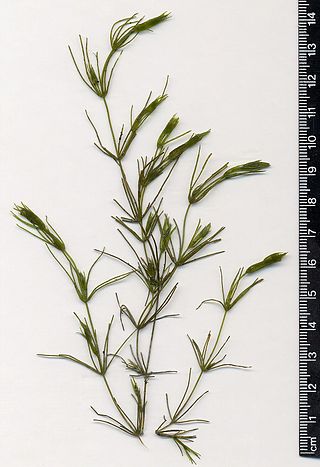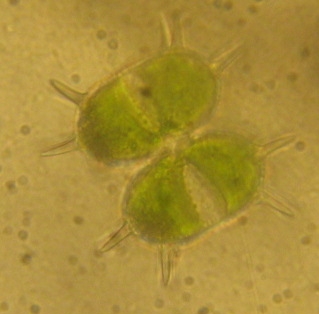
Chlorophyta is a taxon of green algae informally called chlorophytes. The name is used in two very different senses, so care is needed to determine the use by a particular author. In older classification systems, it is a highly paraphyletic group of all the green algae within the green plants (Viridiplantae) and thus includes about 7,000 species of mostly aquatic photosynthetic eukaryotic organisms. In newer classifications, it is the sister clade of the streptophytes/charophytes. The clade Streptophyta consists of the Charophyta in which the Embryophyta emerged. In this latter sense the Chlorophyta includes only about 4,300 species. About 90% of all known species live in freshwater. Like the land plants, green algae contain chlorophyll a and chlorophyll b and store food as starch in their plastids.

The Zygnematales, also called the Conjugatales, are an order of green algae, comprising several thousand different species in two families. The larger family Zygnemataceae, with well-known genera such as Zygnema and Spirogyra, includes members that grow as unbranched filaments, which grow longer through normal cell division. This group includes the desmids. Most members of both families live in freshwater, and form an important component of the algal scum that grows on or near plants and rocks.

Desmidiales, commonly called the desmids, are an order in the Charophyta, a division of green algae in which the land plants (Embryophyta) emerged. Desmids consist of single-celled microscopic green algae. Because desmids are highly symmetrical, attractive, and come in a diversity of forms, they are popular subjects for microscopists, both amateur and professional.

The green algae are a group of chlorophyll-containing autotrophic eukaryotes consisting of the phylum Prasinodermophyta and its unnamed sister group that contains the Chlorophyta and Charophyta/Streptophyta. The land plants (Embryophytes) have emerged deep in the Charophyte alga as a sister of the Zygnematophyceae. Since the realization that the Embryophytes emerged within the green algae, some authors are starting to include them. The completed clade that includes both green algae and embryophytes is monophyletic and is referred to as the clade Viridiplantae and as the kingdom Plantae. The green algae include unicellular and colonial flagellates, most with two flagella per cell, as well as various colonial, coccoid and filamentous forms, and macroscopic, multicellular seaweeds. There are about 22,000 species of green algae, many of which live most of their lives as single cells, while other species form coenobia (colonies), long filaments, or highly differentiated macroscopic seaweeds.

Streptophyta, informally the streptophytes, is a clade of plants. The composition of the clade varies considerably between authors, but the definition employed here includes land plants and all green algae except the Chlorophyta and the more basal Prasinodermophyta.

Charophyta is a group of freshwater green algae, called charophytes, sometimes treated as a division, yet also as a superdivision or an unranked clade. The terrestrial plants, the Embryophyta emerged deep within Charophyta, possibly from terrestrial unicellular charophytes, with the class Zygnematophyceae as a sister group.

The Zygnemataceae are a family of filamentous or unicellular, uniseriate (unbranched) green algae. The filaments are septated and reproduction is by conjugation; Spirogyra is commonly used in schools to demonstrate this kind of reproduction. The family is notable for its diversely shaped chloroplasts, such as stellate in Zygnema, helical in Spirogyra, and flat in Mougeotia. The Zygnemataceae are cosmopolitan, but though all generally occur in the same types of habitats, Mougeotia, Spirogyra, and Zygnema are by far the most common; in one study across North America, 95% of the Zygnemataceae collected were in these three genera. Classification and identification is primarily by the morphology of the conjugation, which is somewhat rare to find in natural populations of permanent water bodies; when in the vegetative state, the rarer genera resemble the three most common, and are often mistaken for them and catalogued as such. Conjugation can be induced in low-nitrogen culture. While they occupy many habitats, in North America all are found solely in freshwater or subaerial habitats. Species typically exist as floating mats in stagnant water in ditches and ponds, but some also grow in moving water, attaching themselves to a substrate by rhizoid-like projections of the basal cells of the filament. The mat species rise to the surface in early spring, grow rapidly through the summer, disappearing by late summer. Members of the Zygnemataceae, such as Spirogyra, fall prey to parasites, especially chytrids. Most genera previously assigned to Mesotaeniaceae as well as the Desmidiales actually emerged in the Zygnematacae.

Micrasterias is a unicellular green alga of the order Desmidiales. Its species vary in size reaching up to hundreds of microns.

Viridiplantae constitute a clade of eukaryotic organisms that comprises approximately 450,000–500,000 species that play important roles in both terrestrial and aquatic ecosystems. They include the green algae, which are primarily aquatic, and the land plants (embryophytes), which emerged from within them. Green algae traditionally excludes the land plants, rendering them a paraphyletic group. However it is accurate to think of land plants as a kind of alga. Since the realization that the embryophytes emerged from within the green algae, some authors are starting to include them. They have cells with cellulose in their cell walls, and primary chloroplasts derived from endosymbiosis with cyanobacteria that contain chlorophylls a and b and lack phycobilins. Corroborating this, a basal phagotroph archaeplastida group has been found in the Rhodelphydia.

Charophyceae is a class of charophyte green algae. AlgaeBase places it in division Charophyta. Extant (living) species are placed in a single order Charales, commonly known as "stoneworts" and "brittleworts". Fossil members of the class may be placed in separate orders, e.g. Sycidiales and Trochiliscales.

The Archaeplastida are a major group of eukaryotes, comprising the photoautotrophic red algae (Rhodophyta), green algae, land plants, and the minor group glaucophytes. It also includes the non-photosynthetic lineage Rhodelphidia, a predatorial (eukaryotrophic) flagellate that is sister to the Rhodophyta, and probably the microscopic picozoans. The Archaeplastida have chloroplasts that are surrounded by two membranes, suggesting that they were acquired directly through a single endosymbiosis event by phagocytosis of a cyanobacterium. All other groups which have chloroplasts, besides the amoeboid genus Paulinella, have chloroplasts surrounded by three or four membranes, suggesting they were acquired secondarily from red or green algae. Unlike red and green algae, glaucophytes have never been involved in secondary endosymbiosis events.

Cosmarium is a genus of freshwater organisms belonging to the Charophyta, a division of green algae from which the land plants (Embryophyta) emerged.

Xanthidium is a genus of green algae, specifically of the Desmidiaceae.
The Mesostigmatophyceae are a class of basal green algae found in freshwater. In a narrow circumscription, the class contains a single genus, Mesostigma. AlgaeBase then places the order within its circumscription of Charophyta. A clade containing Chlorokybus and Spirotaenia may either be added, or treated as a sister, with Chlorokybus placed in a separate class, Chlorokybophyceae. When broadly circumscribed, Mesostigmatophyceae may be placed as sister to all other green algae, or as sister to all Streptophyta.
Mesostigma is a genus of unicellular biflagellate freshwater green algae, with a single species Mesostigma viride, covered by an outer layer of basket‐like scales instead of a cell wall. As of February 2022, AlgaeBase classified it as the only genus in the family Mesostigmataceae, the only family in the order Mesostigmatales, the only order in the class Mesostigmatophyceae. It is now considered to be one of the earliest diverging members of green plants/algae (Viridiplantae).

The Klebsormidiaceae are a family containing five genera of charophyte green alga forming multicellular, non-branching filaments. The genus Chlorokybus was previously included as well, but this problematic and poorly known genus is now placed in a separate class Chlorokybophyceae.
Sirogonium is a genus of filamentous charophyte green algae of the order Zygnematales. It is found in freshwater areas on all continents but Antarctica. Spirogyra measures approximately 32–115 μm in width. Each cell contains 2–10 chloroplasts in a ribbon, in contrast to the closely related genus Spirogyra, which has chloroplasts in a coil. Molecular phylogenetic studies have placed Sirogonium inside a clade consisting of Spirogyra species; in other words, Spirogyra is paraphyletic with respect to Sirogonium.

The Phragmoplastophyta are a proposed sister clade of the Klebsormidiaceae in the Streptophyte/Charophyte clade. The Phragmoplastophyta consist of the Charophycaea and another unnamed clade which contains the Coleochaetophyceae, Zygnematophyceae, Mesotaeniaceae, and Embryophytes. It is an important step in the emergence of land plants within the green algae. It is equivalent to the ZCC clade/grade, cladistically granting the Embryophyta.

Spirotaenia is a genus of basal unicellular green algae that may be sister to the Chlorokybophyceae. It was previously considered to be part of the Zygnemataceae. It is sexually conjugating, a mode of reproduction that was previously only known in the Zygnemataceae/Mesotaeniaceae, the sister groups to the land plants. This is surprising, as Spirotaenia is much more basal. The conjugating process is substantially aberrant. Spirotaenia may actually be more than one distinct lineage which may not be closely related.

The marine Prasinodermophyta are a proposed basal Viridiplantae clade, as sister of another clade comprising the Chlorophyta and the Streptophyta. It consists of the Prasinodermophyceae and the Palmophyllophyceae. They were previously considered to be a basal Chlorophyta clade, or part of the "Prasinophytes".















